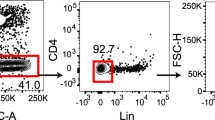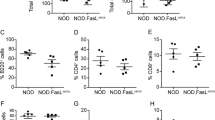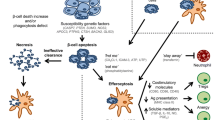Abstract
Aims/hypothesis
Type 1 diabetes results from T cell-mediated destruction of pancreatic beta cells. The mechanisms of beta cell destruction in vivo, however, remain unclear. We aimed to test the relative roles of the main cell death pathways: apoptosis, necrosis and necroptosis, in beta cell death in the development of CD4+ T cell-mediated autoimmune diabetes.
Methods
We altered expression levels of critical cell death proteins in mouse islets and tested their ability to survive CD4+ T cell-mediated attack using an in vivo graft model.
Results
Loss of the B cell leukaemia/lymphoma 2 (BCL-2) homology domain 3-only proteins BIM, PUMA or BID did not protect beta cells from this death. Overexpression of the anti-apoptotic protein BCL-2 or combined deficiency of the pro-apoptotic multi-BCL2 homology domain proteins BAX and BAK also failed to prevent beta cell destruction. Furthermore, loss of function of the death receptor Fas or its essential downstream signalling molecule Fas-associated death domain (FADD) in islets was also not protective. Using electron microscopy we observed that dying beta cells showed features of necrosis. However, islets deficient in receptor-interacting serine/threonine protein kinase 3 (RIPK3), a critical initiator of necroptosis, were still normally susceptible to CD4+ T cell-mediated destruction. Remarkably, simultaneous inhibition of apoptosis and necroptosis by combining loss of RIPK3 and overexpression of BCL-2 in islets did not protect them against immune attack either.
Conclusions/interpretation
Collectively, our data indicate that beta cells die by necrosis in autoimmune diabetes and that the programmed cell death pathways apoptosis and necroptosis are both dispensable for this process.





Similar content being viewed by others
Abbreviations
- BAK:
-
BCL-2 antagonist/killer
- BAX:
-
BCL-2-associated X protein
- BCL-2:
-
B cell leukaemia/lymphoma 2
- BH:
-
BCL-2 homology domain
- BID:
-
BH3-interacting domain death agonist
- BIM:
-
BCL-2-like 11 (apoptosis facilitator)
- ER:
-
Endoplasmic reticulum
- FADD:
-
Fas-associated death domain
- FasL:
-
Fas ligand
- IVIS:
-
In vivo imaging system
- MLKL:
-
Mixed lineage kinase domain-like
- PUMA:
-
BCL-2-binding component 3
- RIP:
-
Rat insulin promoter
- RIPK:
-
Receptor-interacting serine/threonine protein kinase
- ROS:
-
Reactive oxygen species
- TEM:
-
Transmission electron microscopy
References
Eizirik DL, Colli ML, Ortis F (2009) The role of inflammation in insulitis and beta-cell loss in type 1 diabetes. Nat Rev Endocrinol 5:219–226
Graham KL, Sutherland RM, Mannering SI et al (2012) Pathogenic mechanisms in type 1 diabetes: the islet is both target and driver of disease. Rev Diabet Stud 9:148–168
Fuchs Y, Steller H (2011) Programmed cell death in animal development and disease. Cell 147:742–758
Jost PJ, Grabow S, Gray D et al (2009) XIAP discriminates between type I and type II FAS-induced apoptosis. Nature 460:1035–1039
Barthson J, Germano CM, Moore F et al (2011) Cytokines tumor necrosis factor-alpha and interferon-gamma induce pancreatic beta-cell apoptosis through STAT1-mediated Bim protein activation. J Biol Chem 286:39632–39643
McKenzie MD, Jamieson E, Jansen ES et al (2010) Glucose induces pancreatic islet cell apoptosis that requires the BH3-only proteins Bim and Puma and multi-BH domain protein Bax. Diabetes 59:644–652
Wali JA, Rondas D, McKenzie MD et al (2014) The proapoptotic BH3-only proteins Bim and Puma are downstream of endoplasmic reticulum and mitochondrial oxidative stress in pancreatic islets in response to glucotoxicity. Cell Death Dis 5:e1124
Vandenabeele P, Galluzzi L, Vanden Berghe T, Kroemer G (2010) Molecular mechanisms of necroptosis: an ordered cellular explosion. Nat Rev Mol Cell Biol 11:700–714
Sun L, Wang H, Wang Z et al (2012) Mixed lineage kinase domain-like protein mediates necrosis signaling downstream of RIP3 kinase. Cell 148:213–227
Murphy JM, Czabotar PE, Hildebrand JM et al (2013) The pseudokinase MLKL mediates necroptosis via a molecular switch mechanism. Immunity 39:443–453
Augstein P, Stephens LA, Allison J et al (1998) Beta-cell apoptosis in an accelerated model of autoimmune diabetes. Mol Med 4:495–501
Kurrer MO, Pakala SV, Hanson HL, Katz JD (1997) Beta cell apoptosis in T cell-mediated autoimmune diabetes. Proc Natl Acad Sci U S A 94:213–218
Meier JJ, Bhushan A, Butler AE, Rizza RA, Butler PC (2005) Sustained beta cell apoptosis in patients with long-standing type 1 diabetes: indirect evidence for islet regeneration? Diabetologia 48:2221–2228
O'Brien BA, Harmon BV, Cameron DP, Allan DJ (1997) Apoptosis is the mode of beta-cell death responsible for the development of IDDM in the nonobese diabetic (NOD) mouse. Diabetes 46:750–757
Watanabe A, Nishijima K, Zhao S et al (2012) Quantitative determination of apoptosis of pancreatic beta-cells in a murine model of type 1 diabetes mellitus. J Nucl Med Off Publ Soc Nucl Med 53:1585–1591
Charriaut-Marlangue C, Ben-Ari Y (1995) A cautionary note on the use of the TUNEL stain to determine apoptosis. Neuroreport 7:61–64
Irawaty W, Kay TW, Thomas HE (2002) Transmembrane TNF and IFNgamma induce caspase-independent death of primary mouse pancreatic beta cells. Autoimmunity 35:369–375
McKenzie MD, Carrington EM, Kaufmann T et al (2008) Proapoptotic BH3-only protein Bid is essential for death receptor-induced apoptosis of pancreatic beta-cells. Diabetes 57:1284–1292
Steer SA, Scarim AL, Chambers KT, Corbett JA (2006) Interleukin-1 stimulates beta-cell necrosis and release of the immunological adjuvant HMGB1. PLoS Med 3:e17
Pakala SV, Chivetta M, Kelly CB, Katz JD (1999) In autoimmune diabetes the transition from benign to pernicious insulitis requires an islet cell response to tumor necrosis factor alpha. J Exp Med 189:1053–1062
Allison J, Thomas HE, Catterall T, Kay TW, Strasser A (2005) Transgenic expression of dominant-negative Fas-associated death domain protein in beta cells protects against Fas ligand-induced apoptosis and reduces spontaneous diabetes in nonobese diabetic mice. J Immunol 175:293–301
Allison J, Thomas H, Beck D et al (2000) Transgenic overexpression of human Bcl-2 in islet beta cells inhibits apoptosis but does not prevent autoimmune destruction. Int Immunol 12:9–17
Mollah ZU, Wali J, McKenzie MD et al (2011) The pro-apoptotic BH3-only protein Bid is dispensable for development of insulitis and diabetes in the non-obese diabetic mouse. Apoptosis 16:822–830
Allison J, Strasser A (1998) Mechanisms of beta cell death in diabetes: a minor role for CD95. Proc Natl Acad Sci U S A 95:13818–13822
Katz JD, Wang B, Haskins K, Benoist C, Mathis D (1993) Following a diabetogenic T cell from genesis through pathogenesis. Cell 74:1089–1100
Bouillet P, Purton JF, Godfrey DI et al (2002) BH3-only Bcl-2 family member Bim is required for apoptosis of autoreactive thymocytes. Nature 415:922–926
Villunger A, Michalak EM, Coultas L et al (2003) p53- and drug-induced apoptotic responses mediated by BH3-only proteins puma and noxa. Science 302:1036–1038
Takeuchi O, Fisher J, Suh H, Harada H, Malynn BA, Korsmeyer SJ (2005) Essential role of BAX, BAK in B cell homeostasis and prevention of autoimmune disease. Proc Natl Acad Sci U S A 102:11272–11277
Virostko J, Radhika A, Poffenberger G et al (2010) Bioluminescence imaging in mouse models quantifies beta cell mass in the pancreas and after islet transplantation. Mol Imaging Biol 12:42–53
Beisner DR, Ch'en IL, Kolla RV, Hoffmann A, Hedrick SM (2005) Cutting edge: innate immunity conferred by B cells is regulated by caspase-8. J Immunol 175:3469–3473
Ventura A, Kirsch DG, McLaughlin ME et al (2007) Restoration of p53 function leads to tumour regression in vivo. Nature 445:661–665
Newton K, Sun X, Dixit VM (2004) Kinase RIP3 is dispensable for normal NF-kappa Bs, signaling by the B-cell and T-cell receptors, tumor necrosis factor receptor 1, and Toll-like receptors 2 and 4. Mol Cell Biol 24:1464–1469
Dudek NL, Thomas HE, Mariana L et al (2006) Cytotoxic T-cells from T-cell receptor transgenic NOD8.3 mice destroy beta-cells via the perforin and Fas pathways. Diabetes 55:2412–2418
Kanagawa O, Militech A, Vaupel BA (2002) Regulation of diabetes development by regulatory T cells in pancreatic islet antigen-specific TCR transgenic nonobese diabetic mice. J Immunol 168:6159–6164
Newton K, Harris AW, Bath ML, Smith KG, Strasser A (1998) A dominant interfering mutant of FADD/MORT1 enhances deletion of autoreactive thymocytes and inhibits proliferation of mature T lymphocytes. EMBO J 17:706–718
Lum JJ, Bauer DE, Kong M et al (2005) Growth factor regulation of autophagy and cell survival in the absence of apoptosis. Cell 120:237–248
Degterev A, Huang Z, Boyce M et al (2005) Chemical inhibitor of nonapoptotic cell death with therapeutic potential for ischemic brain injury. Nat Chem Biol 1:112–119
Cho YS, Challa S, Moquin D et al (2009) Phosphorylation-driven assembly of the RIP1-RIP3 complex regulates programmed necrosis and virus-induced inflammation. Cell 137:1112–1123
He S, Wang L, Miao L et al (2009) Receptor interacting protein kinase-3 determines cellular necrotic response to TNF-alpha. Cell 137:1100–1111
Zhang DW, Shao J, Lin J et al (2009) RIP3, an energy metabolism regulator that switches TNF-induced cell death from apoptosis to necrosis. Science 325:332–336
Bradley BJ, Haskins K, La Rosa FG, Lafferty KJ (1992) CD8 T cells are not required for islet destruction induced by a CD4+ islet-specific T-cell clone. Diabetes 41:1603–1608
Christianson SW, Shultz LD, Leiter EH (1993) Adoptive transfer of diabetes into immunodeficient NOD-scid/scid mice. Relative contributions of CD4+ and CD8+ T-cells from diabetic versus prediabetic NOD.NON-Thy-1a donors. Diabetes 42:44–55
Kay TW, Campbell IL, Harrison LC (1991) Characterization of pancreatic T lymphocytes associated with beta cell destruction in the non-obese diabetic (NOD) mouse. J Autoimmun 4:263–276
Kagi D, Odermatt B, Seiler P, Zinkernagel RM, Mak TW, Hengartner H (1997) Reduced incidence and delayed onset of diabetes in perforin-deficient nonobese diabetic mice. J Exp Med 186:989–997
Wang B, Gonzalez A, Benoist C, Mathis D (1996) The role of CD8+ T cells in the initiation of insulin-dependent diabetes mellitus. Eur J Immunol 26:1762–1769
Hamilton-Williams EE, Palmer SE, Charlton B, Slattery RM (2003) Beta cell MHC class I is a late requirement for diabetes. Proc Natl Acad Sci U S A 100:6688–6693
Calderon B, Suri A, Unanue ER (2006) In CD4+ T-cell-induced diabetes, macrophages are the final effector cells that mediate islet beta-cell killing: studies from an acute model. Am J Pathol 169:2137–2147
Angstetra E, Graham KL, Emmett S et al (2009) In vivo effects of cytokines on pancreatic beta-cells in models of type I diabetes dependent on CD4(+) T lymphocytes. Immunol Cell Biol 87:178–185
Lenzen S, Drinkgern J, Tiedge M (1996) Low antioxidant enzyme gene expression in pancreatic islets compared with various other mouse tissues. Free Radic Biol Med 20:463–466
Welsh N, Margulis B, Borg LA et al (1995) Differences in the expression of heat-shock proteins and antioxidant enzymes between human and rodent pancreatic islets: implications for the pathogenesis of insulin-dependent diabetes mellitus. Mol Med 1:806–820
Fujimoto K, Chen Y, Polonsky KS, Dorn GW 2nd (2010) Targeting cyclophilin D and the mitochondrial permeability transition enhances beta-cell survival and prevents diabetes in Pdx1 deficiency. Proc Natl Acad Sci U S A 107:10214–10219
Yang YH, Johnson JD (2013) Multi-parameter single-cell kinetic analysis reveals multiple modes of cell death in primary pancreatic beta-cells. J Cell Sci 126:4286–4295
Acknowledgements
We thank the following people: J. Allison (St Vincent’s Institute, Fitzroy, VIC), J. Silke, P. Bouillet, S. Cory, J. M. Adams, W. Alexander, J. Murphy (all WEHI, Parkville, VIC), A. Villunger (University of Innsbruck, Innsbruck, Austria), S Hedrick (UCSD, San Diego, CA), A Powers (Vanderbilt University, Nashville, TN), D. Mathis (Joslin Diabetes Center, Boston, MA) and K. Newton (Genentech, South San Francisco, CA) for gifts of mice; O. Kanagawa (Osaka University, Osaka, Japan) for BDC2.5 antibody; S. Thorburn, T. Smith, E. Duff, D. Novembre-Cycon, R. Branch and A. Gomes (St Vincent’s Institute, Fitzroy, VIC) for genotyping and animal husbandry and S. Ellis, S. Asquith and J. Danne (all Peter MacCallum Cancer Center, East Melbourne, VIC) for electron microscopy. These data were presented as an abstract at the Immunology of Diabetes Society meeting in 2013.
Funding
This work was funded by a National Health and Medical Research Council of Australia (NHMRC) and Juvenile Diabetes Research Foundation (JDRF) joint special program grant in type 1 diabetes, program grants (HET, TWHK and AS) and fellowships from the NHMRC (HET and AS), a Leukemia and Lymphoma Society SCOR grant (AS) and a Postdoctoral Fellowship from the JDRF (YZ). The St Vincent’s Institute and The Walter and Eliza Hall Institute receive support from the Operational Infrastructure Support Scheme of the Government of Victoria. This work was made possible through a Victorian State Government OIS grant and an Australian NHMRC IRIIS grant.
Contribution statement
YZ, NAS, SF and LE performed experiments, analysed data and critically revised the manuscript. YZ, NAS and HET designed the study and wrote the manuscript. WWW, KDM, AS, DCH and TWHK contributed reagents, contributed to conception, design and interpretation of this work and critically revised the manuscript. All authors approved the final version of the manuscript. HET is responsible for the integrity of the work as a whole.
Duality of interest
The authors declare that there is no duality of interest associated with this manuscript.
Author information
Authors and Affiliations
Corresponding author
Rights and permissions
About this article
Cite this article
Zhao, Y., Scott, N.A., Fynch, S. et al. Autoreactive T cells induce necrosis and not BCL-2-regulated or death receptor-mediated apoptosis or RIPK3-dependent necroptosis of transplanted islets in a mouse model of type 1 diabetes. Diabetologia 58, 140–148 (2015). https://doi.org/10.1007/s00125-014-3407-5
Received:
Accepted:
Published:
Issue Date:
DOI: https://doi.org/10.1007/s00125-014-3407-5




